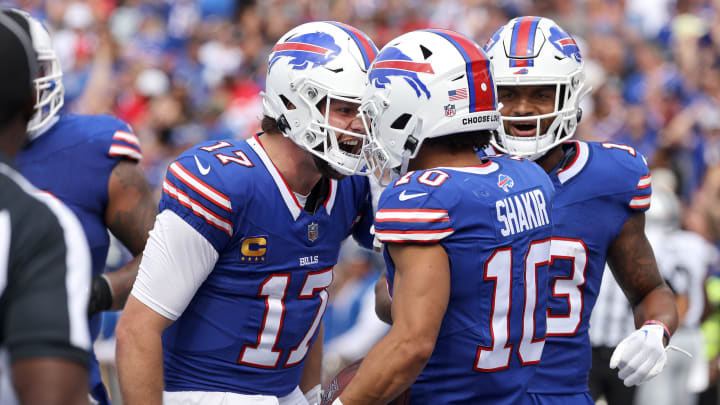Bills' revamped WR corps dubbed team's 'biggest red flag' entering 2024 NFL season

The Buffalo Bills made significant—and perhaps initially unplanned—alterations to their receiving corps in the 2024 offseason, parting ways with Gabriel Davis, Trent Sherfield, and Deonte Harty as free agents before trading perennial Pro Bowler Stefon Diggs to the Houston Texans in exchange for a premium pick in next year’s NFL draft. The departures—particularly those of Davis and Diggs—leave Buffalo with substantial unaccounted-for production; the two alone combined for 241 targets, 152 receptions, and 1,929 yards in the 2023 season.
The Bills assembled a hodgepodge receiving corps in the wake of the offseason departures, signing free agent veteran Curtis Samuel before drafting trait-sy Florida State pass-catcher Keon Coleman in the second round of the 2024 NFL Draft. Buffalo is also expecting increased production from third-year contributor Khalil Shakir and second-year tight end Dalton Kincaid, both of whom flashed down the stretch of the 2023 season; though Buffalo’s pass-catching corps is certainly different than it was a year ago, there’s enough talent throughout to provoke justifiable optimism.
CBS Sports writer Cody Benjamin seemingly doesn’t share this sentiment. In a recent article for the outlet identifying one “red flag” for each NFL contender, the writer questioned the immediate feasibility of the Bills’ receiving corps, casting fundamental doubt on the team’s approach.
Related: NFL analyst expects major rebound from Bills DE Von Miller: He'll 'make a difference'
“In theory, Buffalo has swapped out one bona fide pass catcher (in this case, Stefon Diggs) for a slew of solid role players: a red zone outlet (Keon Coleman), a utility man (Curtis Samuel) and a speedster (Marquez Valdes-Scantling),” Benjamin wrote. “Is that really a better supporting cast for Josh Allen?”
While it may not be a “better” supporting cast for Allen, it’s certainly one that’s better positioned for the future, which was something Buffalo attempted to make true of its entire roster in the 2024 offseason. The team parted ways with several veterans across the locker room in an attempt to free up long-term financial flexibility and generally get younger; by not signing Davis long-term and removing the final three years of Diggs’ contract (and his roughly $25 million annual cap hit) from the books, the Bills will have the opportunity to make marquee additions in future offseasons.
And these moves may ultimately be made to bolster a pass-catching corps that, again, is already talented; Shakir earned the trust of Allen over the final few games of the 2023 season and looks primed for a year-three breakout. Samuel, though he’s never usurped 1,000 receiving yards in a single season, had his best campaign as a professional under current Buffalo offensive coordinator Joe Brady (totaling 1,051 yards from scrimmage with Brady calling the shots as the offensive coordinator of the Carolina Panthers in 2020). Coleman is a big-bodied target with demonstrable big-play ability (he caught 11 touchdown passes at Florida State last season), and his general skill set is raw enough that the Bills can truly mold him into whatever they please. Kincaid—and veteran tight end Dawson Knox—also need to be mentioned in any conversation about aerial production, as Allen will likely look to them early and often next season.
DALTON KINCAID 29 YARD TOUCHDOWN
— SleeperNFL (@SleeperNFL) January 15, 2024
pic.twitter.com/XgXPgw3Y60
Buffalo’s receiving corps may not be better now than it was at the start of the offseason, but the construction of the unit will allow Allen to spread the ball around and take an egalitarian approach to aerial production as opposed to force-feeding one or two targets. Consider the unit’s relative youth and the financial flexibility the Bills’ offseason maneuvers leave the team with, and it’s difficult not to be optimistic about the future of Buffalo’s receiving corps.
The unproven nature of the unit could reasonably give a national pundit pause, but the talent should be enough to keep the Bills’ aerial attack humming in 2024. Besides, the offense is helmed by an otherworldly quarterback—one can reasonably expect that he’ll elevate the unit above its perceived ceiling this fall.
— Enjoy free coverage of the Bills from Buffalo Bills on SI —
